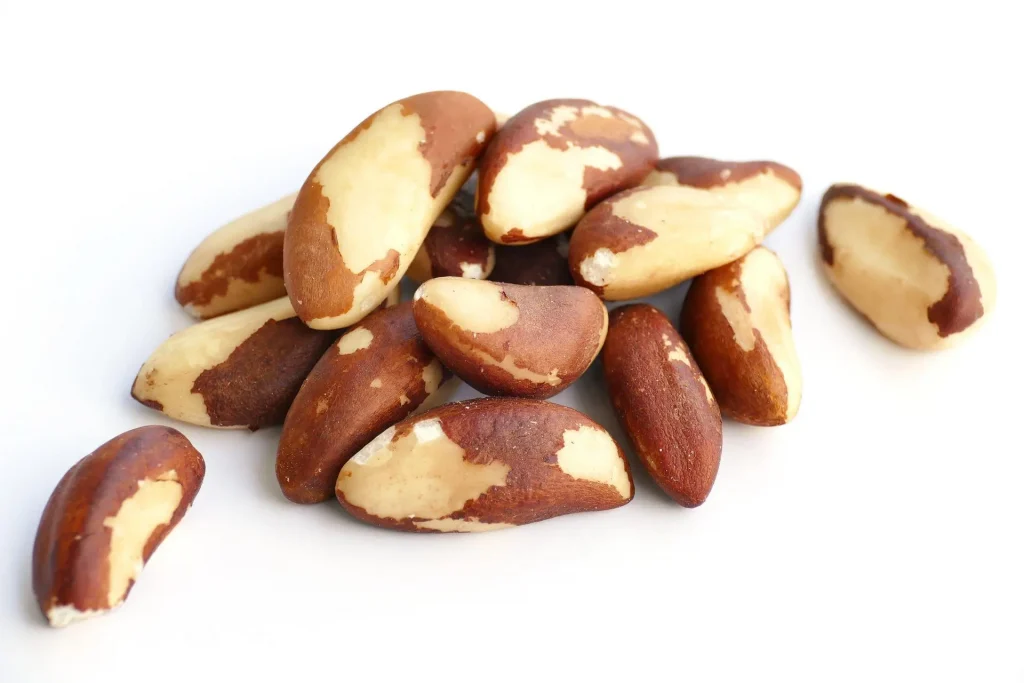The brain only requires oxygen and glucose to function. Higher functions such as thought, self-control, and memory need other nutrients. Foods for a healthy brain and nervous system include almonds, cashew nuts, lettuce, Brazil nut, oats, and pine nut.
There are several conditions of the brain and nervous system including anxiety, depression, insomnia, nervousness, dementia, mental fatigue, and stress.
B-group vitamins help in the healthy function of the brain and nervous system.
Lack of important nutrients such as;
- Vitamin B1 produces irritability and depression.
- Vitamin B6 produces nervousness and fatigue.
Minerals such as magnesium are directly involved in the activity of neurons. Lack of magnesium produces nervousness and anxiety or even cramps and spasms.
Unsaturated fats such as linolenic acid are found in nuts. These are necessary for the development of the nervous system and brain in children.
Excess sugar consumption and artificial coloring affect the nervous system and alter behavior. “Sugar Rush” in younger children is one common problem.
Foods for a Healthy Brain and Nervous System
Cashew Nuts
These are oil-bearing nuts with a pleasant taste. They are produced in tropical climates. They are difficult to process which keeps their prices constantly high.
Cashew nuts are extremely rich in magnesium. This mineral is very important in the transmission of nerve impulses. The magnesium content of these nuts is almost ten times that of meat, milk, and eggs.
This nut also contains unsaturated fatty acids such as oleic and linoleic; vitamins B1 and B2, minerals such as potassium, iron, and phosphorus; and pantothenic acid.

Cashew nuts are recommended in cases of;
- nervousness,
- irritability,
- depression,
- weakness,
- abnormal tiredness
- spasms in hollow organs;
- colon (irritable bowel)
- uterus (period pains)
- coronary arteries (angina pectora)
These nuts are eaten salted or plain like peanuts.
Oats
Oats have the highest content of nutrients of any grain. It is rich in carbohydrates, proteins, phosphorus, magnesium, iron, zinc, potassium, and vitamin B1. They have almost double the amount of iron found in meat.
Oats contain the most important nutrients for the proper functioning of the nervous system. These nutrients include glucose (released from starch), fatty acids, phosphorus, lecithin, and vitamin B1. They also improve mental performance, energy, and stability.

Oats are recommended in cases of;
- nervousness
- fatigue
- mental exhaustion
- insomnia
- depression
- concentration for students especially during exam time.
Important substances found in oats include;
- Starch produces dextrin, maltose, and glucose which provide the body with energy.
- Fructose is highly recommended for those with diabetes.
- Mucilage has a gelatinous consistency when mixed with water. This lubricates and softens the insides of the intestines. It is beneficial in cases of gastritis and colitis.
- The vegetable fiber found in the outer covering has a mild laxative effect and lowers cholesterol levels by absorbing and removing bile acids from the intestine.
- Essential amino acids are found in proteins.
- Fatty acids including linoleic slow the production of cholesterol.
- Avenastrol interferes with the absorption of cholesterol in the intestine.
- Lecithin improves nerve function and lowers blood cholesterol levels.
Oats are also useful in other conditions;
- Diabetes: Oats are very well tolerated by diabetics despite their high carbohydrate content. This is because of their high fructose content.
- Digestive disturbances such as gastritis, duodenal ulcer, colitis. This is due to ease of digestion and mucilage content.
- Lowering of cholesterol: The fats in oats lower cholesterol levels by retaining and eliminating bile salts in the intestine while reducing the absorption of fats.
- Hypertension and arteriosclerosis (narrowing of the arteries)
Oat flakes are prepared and used in a variety of ways;
- Flakes: boiled with milk and served with honey and may be served with pieces of apple or banana. This makes an excellent breakfast.
- Porridge or oatmeal: Soaked in water overnight. Then cooked for 15 minutes and served with honey. Milk may be added.
- Flour or cream: Used for soups and baby foods.
- Oat water: Oats are boiled in water for five minutes and then strained. The liquid may be sweetened with honey.
- Muesli: This basic breakfast food is prepared with oat flakes as one of the basic ingredients. In addition to almonds, raisins, hazelnuts, and other grains. Muesli is served with fresh fruit, milk, and honey.
Almonds
Almonds are nuts that invigorate the nervous system and reduce cholesterol.
They are rich in all primary nutrients and are considered a superfood. They are among the richest plant-based foods in calcium and phosphorus. The calcium content of almonds is greater than that of milk. A lack of calcium in the blood produces nervousness. These nuts also contain high amounts of magnesium, potassium, and iron. The balance among these minerals maintains muscle tone and prevents nervous irritability.

Almonds are useful in;
- strengthening the nerves.
- toning the muscles.
- helping overcome stress, depression, and fatigue.
Other components found in almonds are;
- Proteins: Almond proteins are easily absorbed by the body and contain a complete set of essential amino acids. The protein content in almonds is almost as high as that of fish and meat.
- Fat: They contain healthy fats. Linoleum acid derived from these promote a healthy nervous system.
- Vitamins: These nuts are rich in vitamins B, B6, and vitamin E.
Almonds are also useful in other conditions;
- Bone disorders such as osteoporosis and demineralization: Almonds contain high levels of the minerals which build bones (calcium, phosphorus, and magnesium). The nuts are also alkalizing which encourages calcium retention.
- Lowering of cholesterol: The balanced composition of fatty acids, richness in vitamins as well as antioxidant properties lower cholesterol levels.
- Heart disease: Calcium and vitamin E in almonds promote heart health.
- Arteriosclerosis: Vitamin E which is an antioxidant prevents the thickening and hardening of the arteries.
- Pregnancy: The rich mineral content of almonds helps with healthy fetal development.
- Lactating mothers: Almonds increase milk production in lactating mothers.
- Diabetes: Ideal for those with diabetes because of their low carbohydrate content.
Almonds may be prepared and used in several ways;
- Raw: The nuts are picked from the tree and shelled. These are easier to digest than when dried.
- Dried: These can be eaten raw or lightly toasted.
- Almond milk: Is a substitute for milk. Prepared by adding water to almond cream.
Almond Milk
This is a very nutritious beverage comparable to cow’s milk in protein and mineral content. Almond milk may be used in certain conditions;
- Intolerance to cow’s milk caused by lactose intolerance.
- Excess blood cholesterol.
- Lactating mothers to increase milk production.
- Infants and children: it is rich in calories and nutrients.
- The elderly who may be unable to chew almonds.
- Infantile eczema and diarrhea: as a substitute for cow’s milk.
Lettuce
This is a leafy vegetable that calms the nerves and also satisfies the stomach.

This vegetable is very rich in water and relatively high in protein. It is low in carbohydrates which means it contributes little to give the body energy. Regular lettuce consumption produces a mild sedative effect while also providing B vitamins for the stability of the nervous system. This is helpful in disorders of the nervous system such as nervousness, stress, or anxiety.
Other components found in lettuce are pro-vitamin A, vitamin B1, B2, folates, and vitamin C. This vegetable is also rich in potassium, iron, and other minerals such as calcium phosphorus, and magnesium. Trace elements zinc, copper, and manganese are also present.
Lettuce is also helpful in other conditions;
- Insomnia: It is a mild sedative and sleep-inducing. Ideal when eaten at night.
- Aids digestion: Tones the stomach when eaten before a meal.
- Constipation: Its fiber content assists in intestinal function.
- Diabetes: The vegetable is low in carbohydrates.
- Weight loss and obesity: It is filling while providing very few calories.
This vegetable may be eaten raw dressed in olive oil or cooked like any other green leafy vegetable.
Pine Nuts
Pine Nuts are generally used as a condiment because of their relative scarcity and high price. They are delicious in baked goods or fine cuisine. The nuts are rich in polyunsaturated fatty acids such as linoleic and pinoleic acids which are very important in the formation of nerve tissue. Pine nuts have a high vitamin B1 content and are useful for those suffering from stress and depression.

These nuts are ideal for other conditions such as;
- Anemia, because of their high mineral content such as iron as well as other nutrients.
- Heart disease and arteriosclerosis, are due to the effect of fatty acids on the arteries.
Pine nuts may be eaten raw if well chewed. They become rancid very easily so must be stored well in an air-tight container.
Brazil Nuts
Brazil nuts are extremely rich in vitamin B1 which is higher than that in meat, milk, or eggs. This makes them ideal for those with nervous disorders such as depression, irritability, memory loss, lack of concentration, and mental performance.

These nuts also assist those who want to stop smoking because of the effect of B1 on the nervous system.
Brazil nuts may be eaten raw, but chewed well.
They may also be toasted for 5 to 10 minutes in an oven till they turn golden brown.
Conditions Affecting the Nervous System
- Anxiety: Negative emotional state that is psychosomatic. The brain first then the other parts of the body producing stomach pain or alternating constipation and diarrhea.
- Depression: Feelings of worthlessness, dejection, and social withdrawal.
- Headaches/migraines: Headaches are general head pain. Migraines are a special type of headache which is sharp and throbbing. It occurs suddenly and may be accompanied by nausea, vomiting, or blurred vision.
- Dementia: Progressive and generally irreversible loss of mental faculties.
- Insomnia: Inability to sleep well.
- Schizophrenia: A hereditary mental disease characterized by changes in personality and hallucinations.
- Epilepsy: Disease of the central nervous system manifested by seizures.
- Multiple sclerosis: Disease affecting the nerves of speech, skin sensitivity, or movement.
- Bulimia: An eating disorder characterized by uncontrolled appetite. Opposite of anorexia.
- Anorexia: Disorder in which food is refused with the objective of rapid weight loss.
- Neuralgia: A disease of sensitive nerves that produce sharp pain.
- Mental stress: Produced when one is unable to cope with events of life.
- Parkinson’s disease: Characterized by the inability to move muscles, loss of power for voluntary movement, and tremors.
- Alzheimer’s disease: A type of progressive dementia. Affects women more than men.
- Hyperactivity / aggression: Extreme restlessness/Forcefulness.
- Mental fatigue: Tiredness due to low brain energy level.
- Nervousness: The nervous system reacts disproportionately to normal stimuli when in an excited or irritated state.
References
- Nutritional value and health benefits of nuts
- Nuts and Human Health Outcomes: A Systematic Review
- Almonds (Prunus Dulcis Mill. D. A. Webb): A Source of Nutrients and Health-Promoting Compounds
- The nutritional and health benefits of almonds: a healthy food choice
- Nutritional value, bioactive compounds, and health benefits of lettuce (Lactuca sativa L.)
- The Potential of Pine Nut as a Component of Sport Nutrition
- Brazil nuts and associated health benefits: A review

